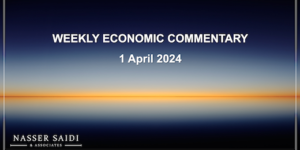Markets
Global stock markets were mostly down compared to a week ago. US earnings results failed to impress (banks were dragged down by the disappointing results from JP Morgan Chase) and retail sales data did not help either; Tokyo’s Nikkei meanwhile hit a 15-month high. Regional markets were mostly down – only Bahrain and Saudi made modest gains. Crude retreated below $80 a barrel after cold weather failed to boost demand and the International Energy Agency left its consumption forecasts unchanged.
Global Developments
America:
- Fed’s Beige book reported modest improvements in consumer spending in 2009, though well below pre-recession 2007 data. Labor market was weak while wage and price inflation remained subdued.
- Retail sales for Dec09 disappointed (-0.3% mom, +5.5% yoy); initial jobless claims were up modestly (444k in week ended Jan 9). Dec industrial production was up 0.6% mom, thanks to gains in utilities, but manufacturing was dragged down 0.1%.
- CPI inflation increased 0.13%mom in Dec( +2.7% yoy), less than expected. Core inflation (ex food and energy) increased by a modest 0.11% mom (+1.8% yoy).
Europe:
- France’s industrial production registered a growth of +1.1% mom in Nov09, driven by strong growth in transportation (+5.3%) and electricity goods (+2.5%). Industrial production for Italy and UK (Nov09) were up +0.2% and 0.4% mom respectively.
- Eurozone’s industrial production registered a stronger than expected 1.0% mom growth in Nov.
- The European Central Bank kept its refi rate unchanged at 1.0% and issued a blunt warning to high-borrowing governments that they risked a backlash from financial markets, while escalating pressure on Greece to bring its public debts under control.
Asia and Pacific:
- The People’s Bank of China raised banks’ reserve requirements by 0.5%, taking the markets by surprise. The hike confirms China’s policy tightening move, after concerns about rapid expansion in bank credit in the initial weeks of 2010.
- China’s December trade report, showed robust growth in exports up 70%qoq, saar and, especially, imports up 83%qoq, saar.
- China’s forex reserves were $2.4 tr at end 2009, up $453 bn from end 2008. Q4 posted a gain of $126 billion ($42 bn per month).
- India’s Nov09 industrial production for Nov was up 11.7% yoy, largely due to base effects while a strong pickup in motor vehicle sales and consumer durables reflect robust consumer demand.
- Japan machinery orders, a leading indicator for capex, posted an 11.3% mom decline in Nov09 – a record low. External machinery orders, a leading indicator for capital goods exports, recorded their first yoy increase, of 0.7%, since Jun08.
Bottom line: The outlook for the global economy remains clouded by two main uncertainties: strength of US labour market and the capital markets which are assessing whether the rally in 2009 was overstretched. Draghi head of the Financial Stability Board warned that the general situation “is not as good as the markets think it is…there are very substantial fragilities in the [financial] system”.
Regional Developments
- Saudi Arabia’s bank sector took a hit after Saudi Hollandi Bank made its first quarterly loss in two years while Banque Saudi Fransi and Samba Financial Group also saw profits hit by provisions.
- Gulf banks provisions for bad loans reached $9.4bn in 2009, a 40% increase over 2008 according to Kuwait’s Markaz estimates. However these provisions are a mere 1.13% of loans outstanding.
- The banking sector in KSA (11 banks including those non listed) achieved a 4.1% growth rate to reach $7.4bn net profit in 2009.
- Oman’s banks consolidated balance sheet in the first 11 months of 2009 grew by 4.2% comparing to same period of 2009.
- Oman nominal GDP of first 9 months in 2009 declined by 27% comparing to same period in 2008. Oman government expenditure of first 9 months in 2009 increased by 6.8% comparing to same period in 2008.
- Saudi non oil imports value and weight decreased by 32% and 28% respectively where Saudi non oil exports value and weight decreased by 1% and increased 24% respectively.
- HSBC’s quarterly Gulf Business Confidence Index fell from 81.4 to 80.2 between Q3 and Q4 2009. Saudi and Kuwait indices showed modest gains while UAE declined from 72.2 to 69.8.
- Estimates from the Energy Information Administration showed the combined income of Gulf oil producers fell to $302bn in 2009 from a record high of USD 522bn in 2008, due to the sharp decline in both crude prices and output.
Market Intelligence on the UAE
- Dubai Chamber of Commerce announced that total exports for 2009 fell by 16% yoy to AED 186.1bn, with Dec09 registering a 23% rise in total exports indicating a turnaround and a better outlook for 2010.
- The creation of a judicial panel to hear disputes between Tamweel and Amlak and their creditors could pave the way for a merge. The new panel’s precise mandate has not been disclosed and lawyers fear it may be interfering with judicial courts’ proceedings.
- The Dubai airport recorded +9.2% yoy growth in passengers during 2009 to a record 40.9 mn, in a period when 46 of the world’s 50 busiest airports showed falls in international passenger traffic.
- Sheikh Ahmed bin Zayed al Nahayan, ADIA’s managing director, stated that ADIA had switched its weightings across asset classes to reduce the impact of economic downturns over the past 18 months, adding that its allocation to global equities had averaged 40-60%. Regionally, its largest allocation was the US (35-50%), followed by Europe (up to 35%) and Asia (up to 20%).
- The UAE recorded more than $ 20bn worth of merger and acquisition deals in 2009, of which $ 15.74bn, or more than 77%, were acquisitions made by UAE-based firms, while the remainder was attributed to foreign companies acquiring UAE companies.





